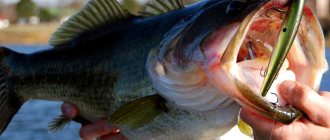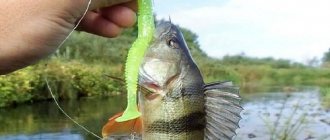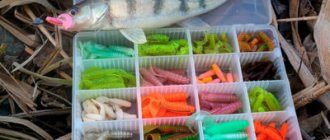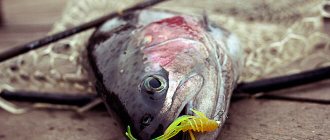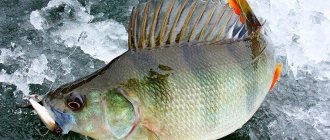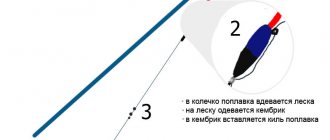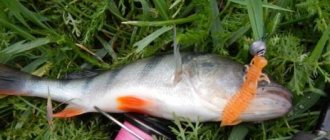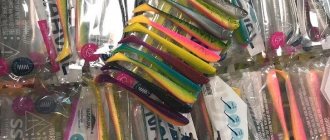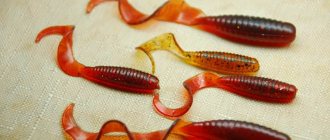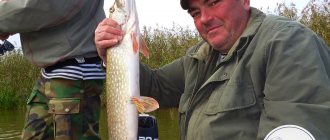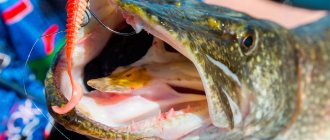Every fisherman has his own secrets on how to achieve a good catch. Some prefer to use homemade tackle, others choose silicone twisters, spoons or wobblers. However, there are more reliable methods that guarantee a good catch. One of the most commonly used is the bass line. You can fish with it even in reservoirs where fish practically do not react to other gear. A garland for perch also gives good results. What are these methods?
Track and features of fishing on it
This type of gear consists of the following components:
- a piece of fishing line, no more than 70 cm long;
- carbine with swivel;
- sinkers, the mass of which is selected in accordance with the parameters of the spinning rod;
- leashes 5-7 cm with hooks;
- twisters.
The choice of the latter depends on the size of the fish that you plan to catch. Experienced spinning players recommend starting with small 2 cm twisters. The color of the bait is usually selected experimentally depending on the reservoir. For muddy water or if you plan to catch perch on a path in the shade, twisters in light colors that match the color of the inhabitants of the lake are suitable. But since fish can peck even on bait of unnatural colors, it is recommended to attach silicones of different colors to one tackle. This will help determine the most catchable ones.
An important factor when fishing on the track is wiring. Since in the process of winding the fishing line you have to make slight jerks, it is better to choose a twitching one. In this case, you can imitate the behavior of a sick fish with one brush. It is possible to use such wiring even on a rigid spinning rod, if you practice well beforehand.
Split shot is a good option
The following method has proven to be excellent when fishing with a microjig; it is called a split shot, reminiscent of a Carolina rig. The differences between them are that in a split shot the sinker is round in shape and rigidly fixed. In the Carolinas, bullet-shaped weights are more commonly used.
Let's get started. We cut the leash to the required length, there are no special recommendations. Its length can be 50-100 cm, the optimal option is selected by trial and error. An offset machine is tied to the segment using any knot, usually a clinch. A loop is made at the other end, threaded into the ear of the eared weight and secured.
Please note that a carabiner is attached to the second free eye of the load, connecting the tackle to the main braided fishing line. This makes it easy to replace it in case of small bites. The video below clearly shows the process of knitting a split.
Garland for perch: features of the gear
Not all fishing enthusiasts use this method. And not at all because it is ineffective. It's faster the other way around. A garland for catching perch is one of the most catchy gear. However, it does not apply to sports, but rather to those used purely for catching fish. The garland consists of a leash, the length of which can reach 2.5 m. It is attached to the main cord. A sinker is usually tied to the end of such tackle. Its weight depends on the depth of the reservoir and the casting distance. Along the length of the garland there are 3 shorter leashes made of thin fishing line. They are equipped with single hooks with bait and are tied to the main one using a swivel or directly. Also, this gear will require a spinning rod with a length of 2.7 m.
Catching perch with a garland can be done with various types of bait: from live to silicone. But micro-twisters are considered the most effective.
How to knit a garland
For fishing with a garland in winter, a fishing rod of any design is suitable. Since the trophies of such fishing usually do not exceed 1 kilogram, a fishing line with a diameter of about 0.15 millimeters is suitable. But for those who are counting on more serious fish, of course, it makes sense to choose a stronger one, based on the situation on the reservoir, you just have to take into account that a thick fishing line is more easily carried away by the current, the play of the tackle with it is less expressive, and besides, it can scare away careful fish.
As for the preferred jigs, the Uralka, Ant and Devil baits work well. Having decided on the number of jigs, you need to select a nod. In most cases, preference should be given to a flat metal nod with the ability to adjust.
For successful fishing with a garland in winter, it is important to choose a nod with optimal rigidity, which, under the load of the garland, goes down at an angle of about 15 degrees. With a softer or harder nod it will be difficult to achieve good play and sensitivity of the tackle.
It is better to tie all jigs, with the exception of the end jig, without knots, this will allow you to achieve maximum strength of the tackle. For knotless fastening of the upper jigs, it is necessary to unwind the required amount of fishing line from the fishing rod, thread its end into the eye of the bait and draw the entire length of the thread through it.
Then wrap this end three times around the fishing line above the bait, again pass it into the eye and pass it, while pulling it into the eye and the place of winding itself.
Interested in tying flies for grayling? Our article will tell you and show you about this.
And here we will talk about the features of catching carp with corn in winter.
Specifics of fishing with a garland
This fishing method has several advantages. The spacing of small leads allows the use of a heavy weight, which makes it possible to cast the tackle far, exploring a large area of water much faster. In addition, you can fish with several different baits at once so that you can later choose the most catchy one.
Perch is caught using a garland as follows. Having set the bait, the fisherman makes a long cast, and then moves the tackle along the bottom of the reservoir, playing with the baits. However, such equipment requires a long rod and can be used in places where there is room to cast it. It is not suitable for reservoirs with a muddy bottom, where there are snags and an abundance of algae. And if you also go through the number of leashes, then confusion arises.
The disadvantages also include the loss of the sports element. This method is more reminiscent of catching fish, so not everyone uses it.
Biting and fishing
Finally, the long-awaited bite occurred. Hook, but make sure the line always remains taut.
Tip: the fishing line should swing to the side, but strictly in the direction of the wind.
Pull the fish out carefully, trying not to catch the line on the edge of the hole. Don't rush, don't make noise, don't fuss, otherwise you will alert or scare away a school of fish. When fishing with a garland, it is important to constantly improve, and then a positive result will not be long in coming.
Read! Secrets of catching roach in the harsh wilderness
Lures for catching perch with a spinning rod
With a good bite, the striped robber will attack almost any type of bait. We will try to highlight the best of them, so to speak. The fact is that there are probably no universal baits that work both day and night, in rain and sun.
You should choose them depending on the time of year, weather, depth, and current speed. Oscillating and rotating spoons are considered classics. We have already talked about the best and catchiest lures for perch, be sure to check out this list of budget models that will not leave you without a catch.
The success of this company is easily explained: perch and pike, which inhabit almost every body of water in the country, bite perfectly on the same spoon. Their size is 00-2, take several types and weights at once. For depth and flow, larger counterparts No.: 2-4 are used. Rotators are perfect for beginners in fishing, as they do not require good fishing skills; it will be enough to rotate the reel evenly.
One of the best baits are wobblers. It is worth remembering that in-ground models are best used during the period when the grass has not had time to grow (spring). In the summer, try different types; surface poppers (yo zuri 3ds is a favorite) using jerk wiring work well.
The main problem is that they are quite vulnerable when caught in snags or grass. It is very easy to hook a wobbler, as well as to lose it. Therefore, when fishing in overgrown and hard-to-reach places, use a non-snagging installation (for example, rubber).
Edible rubber: vibrating tails, twisters, worms. Perch responds well to them at all times of the year, the only difference will be in the size of the bait and the type of wiring. In the fall, feel free to use jig methods with a heavier weight. At this time, fish begin to live in pits and dumps.
In summer, equip your spinning rod with light twisters, small in length and weight. If the spinning test is small (light or ultralight), then fishing for perch is extremely interesting and exciting, regardless of the size of the catch. The whitebait fishing method is relevant at different times of the day, so be sure to try it out!
Tackle and lures for line fishing
Many anglers prefer to use light rods with small twisters. Silicone should be taken from two centimeters and gradually increasing the dimensions. As for colors, everything is checked experimentally. The reel is inertia-free and reliable. Because if we come across a decent-sized pike, we will need good and durable tackle. The fishing line is braided. Why? Stretching the monofilament is of no use to us now.
If you want to simplify your task, take an echo sounder, find out where the fish are, what the topography is like at the bottom of the local body of water, and do the wiring based on the data received. This way you will spend much less time, and your chances increase significantly. No echo sounder? Go through stepped wiring. And then start working on the path as planned. It's a very bad idea to catch at random. There are, of course, exceptions.
The main problem is not at all what gear and bait to take for fishing on the track, but that 50% of anglers use them incorrectly. Hence the hooks and so on. Two minutes of incorrect wiring, and some castmaster decorates the bottom of the river. This is not the best way to end your fishing trip. Often fish bite on fish with completely unrealistic colors for a particular place, without reacting to the natural colors of spinners, similar to local fish. For example, if your target is a pike, remember two simple rules. First, you need a metal leash. Secondly, no sudden changes in trajectory. This is a surefire way to get a hold. The gear is not designed for such abuse. Fishing with a line does not imply “miracles on turns”. All that is required is to drive the boat while playing with the bait.
DIY path for perch made from silicone baits
The most favorable time for active bites is April and May.
The predator hunts only during daylight hours. Perch can bite during the day, but the most successful fishing happens at dawn. You can get some good fish at the end of summer, when minke whales begin to hunt for grown-up fry. The small predator eats crustaceans, caviar, bloodworms, and smaller fellows. Worms, caddis flies, maggots, leeches, as well as fish eyes and even fish entrails are used as bait. But using plant baits is useless; stripers ignore them, as we wrote about in the article “Jig fishing for perch in a pond.”
As for its habitats, it is not difficult to find oysters among aquatic vegetation, reed thickets, and water lilies. From snags, it goes out into shallow water in search of fry. You can often see a school of perch chasing small fish, which splash in different directions, flying out of the water. The whitebait attracts gulls, by the concentration of which it is easy to determine the predator’s hunting areas.
Catching perch with a garland
When fishing for perch, anglers almost always use wobblers and spoons, but completely ignore silicones. And it’s completely in vain; with their help, small minke whales are caught quite successfully. Of all the different forms of rubber bands, rippers and twisters are considered the most catchy.
They are often used in conjunction with jig heads, but the track shows excellent results. In this case, you will need a piece of line 60-70 cm long, no more, otherwise it will be difficult to cast. A carabiner with a swivel is mounted at one end, and a load is tied at the other.
Along the entire length of the line, leashes 5-8 cm long are tied at an equal distance from each other. You should not increase the length of the leashes, otherwise they will begin to wrap around the central line. As for the weight of the lead sinker, it is selected based on the test performance of the fishing rod.
